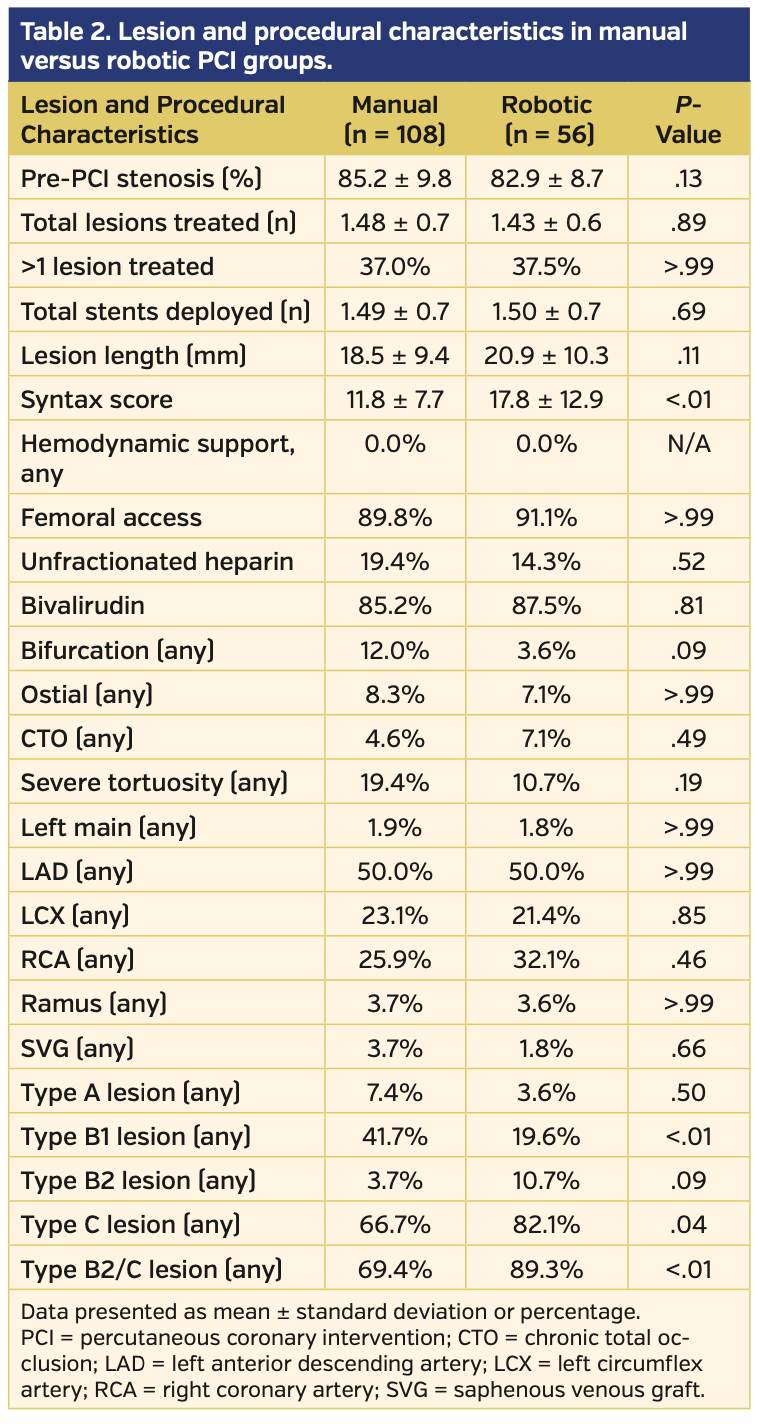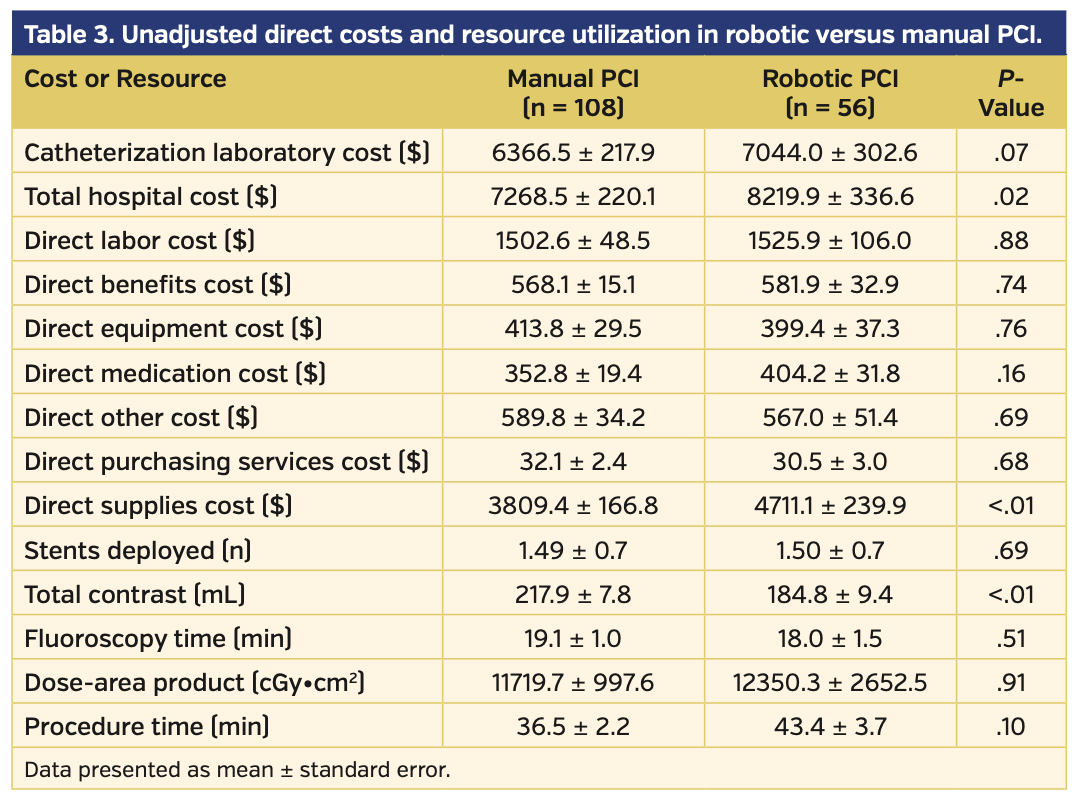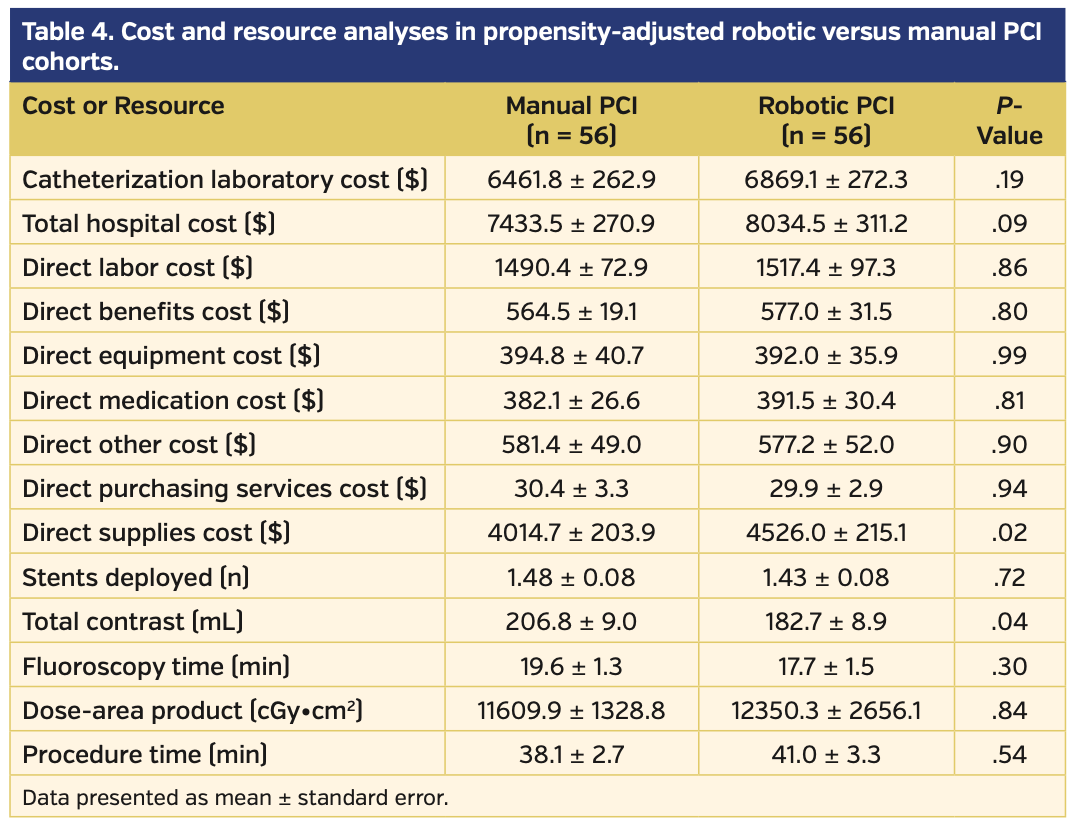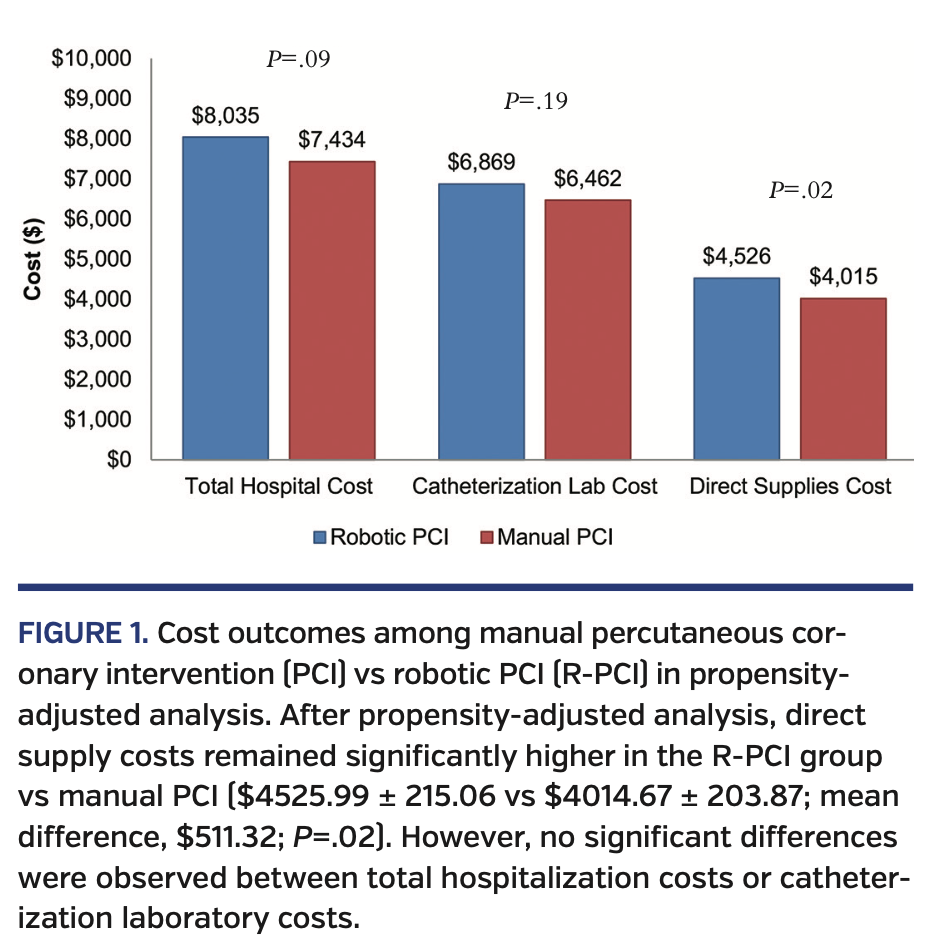ADVERTISEMENT
Resource Utilization During Elective Robotic-Assisted Percutaneous Coronary Intervention
Abstract: Objective. Robotic percutaneous coronary intervention (R-PCI) results in comparable outcomes to manual PCI in the treatment of obstructive coronary artery disease (CAD). The objective of this study is to evaluate the cost and resource utilization of R-PCI compared with manual PCI. Methods. Consecutive patients with CAD undergoing elective R-PCI or manual PCI over an 18-month period by a single operator were included. Procedure-related costs and resource utilization were analyzed and propensity adjusted to account for differences in baseline demographic and lesion characteristics. Results. A total of 164 patients (mean age, 68.9 ± 10.8 years; 81% men) underwent R-PCI (n = 56) or manual PCI (n = 108). The R-PCI group demonstrated higher Syntax scores (17.8 ± 12.9% vs 11.8 ± 7.7%; P<.01) and a greater proportion of type B2/C lesions (89.3% vs 69.4%; P<.01). R-PCI was associated with higher unadjusted costs of total hospitalization ($8219.90 ± 336.60 vs $7268.50 ± 220.10; P=.02) and direct supplies ($4711.10 ± 239.90 vs $3809.40 ± 166.80; P<.01). Following propensity-matched analysis, R-PCI was associated with higher direct supply costs alone, without a significant difference in total hospitalization or catheterization laboratory cost. Furthermore, R-PCI demonstrated similar fluoroscopy time, procedural time, and total number of stents, but with a lower volume of contrast (182.7 ± 8.9 mL vs 206.8 ± 9.0 mL; P=.04). Conclusions. Costs and resources associated with R-PCI are comparable with manual PCI, with an expected increase in direct supply costs attributed to single-use robotic components.
J INVASIVE CARDIOL 2020;32(12):E321-E325. Epub 2020 August 22.
Key words: acute coronary syndromes, coronary artery disease
Percutaneous coronary intervention (PCI) is a cornerstone therapy in the treatment of symptomatic obstructive coronary artery disease and acute coronary syndromes. Despite numerous advances in technologies and techniques for PCI over the past 40 years, its occupational hazards such as radiation exposure and musculoskeletal injury have remained essentially unchanged.1-4 Direct radiation exposure and regular use of heavy protective equipment both pose significant health risks, especially when accrued over the duration of an operator’s career. Furthermore, prior reports have demonstrated an increased prevalence of premature cataract development, left-sided brain malignancies, and orthopedic injuries among interventional cardiologists.5-14 Robotic-assisted PCI (R-PCI) using the CorPath System (Corindus) may potentially mitigate these risks by allowing operators to perform cardiovascular interventions while seated and further away from the interventional table behind protective shielding of the interventional cockpit. R-PCI using the CorPath 200 system results in technical and clinical success rates that are comparable with manual PCI in the treatment of both simple and complex coronary artery lesions.1,15 However, there is a paucity of data regarding resource utilization with R-PCI. This study was undertaken to investigate the cost and resource utilization of R-PCI vs manual PCI at a highly experienced single center using the Complex Robotically Assisted Percutaneous Coronary Intervention (CORA-PCI) study data.16
Methods
Methods for the CORA-PCI study have been previously reported.16 Briefly, consecutive robotic and manual PCI procedures performed at a single center by a single operator over 18 months were included. Data were extracted for the R-PCI cohort from the prospective PRECISION registry (ClinicalTrials.gov identifier, NCT01917682).17 Institutional review board approval and informed consent were obtained for all subjects enrolled as part of the registry. Outcomes for the manual PCI group were collected as reported to the National Cardiovascular Data Registry (NCDR) CathPCI registry. For the current analysis, only subjects who underwent elective outpatient PCI were included. The robotic system has been previously described and consists of an interventional cockpit that communicates with a robotic arm mounted to the catheterization table.2 In all cases of R-PCI, manual engagement of the guiding catheter and loading of an interventional guidewire and balloon catheter were performed before the operator assumed robotic control of the interventional device. The ability of the operator to perform PCI completely robotically vs with any manual assistance has been previously described.1
Direct catheterization laboratory and hospital costs were determined from the hospital billing records and represent charges accrued for a given PCI. All single-use robotic system parts (eg, CorPath 200 cassette, sterile sleeve, etc) were included as part of “direct hospital supplies,” which was a subcategory of total catheterization procedure costs. Components of total hospital cost included total catheterization laboratory costs as well as direct costs of labor, benefits, equipment, medications, purchasing services, and supplies. Measures of resource utilization included total fluoroscopy time, total procedural time, contrast volume, and dose-area product. Procedural time was defined as time between coronary guidewire insertion and final guide-catheter disengagement, as robotic PCI requires manual engagement of the guide catheter prior to transitioning to the robotic system. Postprocedural hemoglobin, creatinine, and peak CK-MB were collected routinely per standard clinical practice.
An adverse clinical event was defined as occurrence of cardiac or non-cardiac death, ischemic or hemorrhagic stroke, access-site complication, major or minor Thrombolysis in Myocardial Infarction (TIMI) bleeding, urgent target-vessel revascularization, or myocardial infarction, which was defined as creatine kinase-myocardial band (CK-MB) elevation >5 times above the upper limit of normal with evidence of myocardial injury or asymptomatic CK-MB elevation >10 times above the upper limit of normal.
Statistical analysis. Data were analyzed using SAS, version 9.4 (SAS Institute). Continuous variables were reported as mean ± standard deviation and categorical variables reported as percentages unless otherwise indicated. Continuous variables were analyzed via Wilcoxon Rank-Sum tests and categorical variables via Fisher’s Exact tests. Propensity scores were estimated using logistic regression and adjusted by matching patients within a score difference of 0.065. Covariates that were significantly related to cost and resource endpoints were also included in the propensity-adjusted analysis. The independent variables included in the propensity score estimation were age, weight, gender, diabetes mellitus, hypertension, hyperlipidemia, chronic kidney disease, prior coronary artery bypass graft surgery, prior PCI, peripheral arterial disease, congestive heart failure, ejection fraction, preprocedure stenosis, target lesion length, Synergy Between PCI With Taxus and Cardiac Surgery (SYNTAX) score, more than one lesion treated, bifurcation disease, ostial disease, chronic total occlusion, severe tortuosity, lesion location, and type B2/C lesion classification. The mean outcomes were compared between R-PCI and manual PCI using bootstrapping.
Results
A total of 164 subjects undergoing elective PCI were included in this analysis (age, 68.9 ± 10.8 years; 81% men), with 108 undergoing manual PCI and 56 undergoing R-PCI. All patients were discharged within 24 hours of the PCI procedure, either same day or next day. An unadjusted comparison of manual vs R-PCI cohort baseline characteristics showed no significant differences with respect to age, weight, gender, diabetes mellitus, hypertension, hyperlipidemia, chronic kidney disease, prior coronary artery bypass graft surgery, prior PCI, peripheral arterial disease, congestive heart failure, or left ventricular ejection fraction (Table 1). The R-PCI group had a lower prevalence of Caucasian patients (53.6% vs 94.4%; P<.001), lower hemoglobin (12.7 ± 1.9 g/dL vs 13.6 ± 1.6 g/dL; P=.02), and higher baseline creatinine (1.39 ± 1.5 mg/dL vs 1.30 ± 1.7 mg/dL; P=.01) vs the manual PCI group, respectively.
Procedural characteristics for the R-PCI group included significantly higher SYNTAX score (17.8 ± 12.9% vs 11.8 ± 7.7%; P<.01), more type B2/C lesions (89.3% vs 69.4%; P<.01), and more type C lesions (82.1% vs 66.7%; P=.04) vs the manual PCI group, respectively.
There were no significant differences in target-lesion percent stenosis, target-lesion length, total lesions treated, total stents deployed, target vessel, and other complex lesion characteristics (Table 2).
R-PCI was associated with higher unadjusted costs of total hospitalization ($8219.86 ± 336.56 vs $7268.47 ± 220.08; P=.02) and direct supplies ($4711.05 ± 239.87 vs $3809.40 ± 166.78; P<.01) vs the manual PCI group, respectively (Table 3). There were no significant differences in the remaining hospital cost components. Catheterization laboratory costs of R-PCI was not statistically different from manual PCI ($7044.02 ± 302.58 vs $6366.50 ± 217.94, respectively; P=.07). No significant differences in fluoroscopy time, dose-area product, or procedural time were identified. R-PCI was associated with lower contrast volume than manual PCI (184.8 ± 9.4 mL vs 217.9 ± 7.8 mL, respectively; P<.01).
Propensity-matched analysis demonstrated no statistically significant differences in catheterization laboratory or total hospital costs (Table 4; Figure 1). Direct supply costs remained significantly higher in the R-PCI group vs manual PCI ($4525.99 ± 215.06 vs $4014.67 ± 203.87, respectively; mean difference, $511.32; P=.02). Fluoroscopy time, dose-area product, and procedure time were similar between both groups after propensity-matched analysis. In this analysis, total contrast use remained lower in the R-PCI group (182.7 ± 8.9 mL vs 206.8 ± 9.0 mL in the manual PCI group; P=.04).
The overall adverse clinical event rate in the entire cohort was extremely low and occurred in 1 patient (0.6%) who underwent R-PCI and had a procedure-related myocardial infarction (asymptomatic CK-MB elevation >10 times the upper limit of normal). All patients were discharged within 24 hours of PCI and no complications required extended hospital stays. Eight of the 56 robotic cases required at least partial manual assistance for various indications, most commonly GuideLiner catheter (Teleflex) support.
Discussion
The findings of this study demonstrate that elective R-PCI using the first-generation CorPath 200 system can be performed with costs comparable to manual PCI and without excess resource utilization, including contrast volume, radiation dose, and procedure time. After propensity-score adjustment, R-PCI demonstrated higher direct supply costs but no significant differences in total hospitalization or catheterization laboratory costs. The increased direct supply costs with R-PCI can be attributed to the single-use cassette and supplies used for each robotic case. With respect to resource utilization, we observed a lower volume of contrast used in the R-PCI group vs manual PCI, but fluoroscopy time, procedural time, and dose-area product did not differ significantly. Last, the incidence of adverse clinical events was infrequent (0.6%), did not prolong length of stay, and did not significantly differ between the groups.
Longer-term effects and other potential cost advantages of R-PCI beyond the index hospitalization were not evaluated in this study. First, reduced contrast use with R-PCI may have sustained benefits to renal function beyond the index procedure. Higher contrast loads are associated with an increased incidence of contrast nephropathy, particularly among those with pre-existing renal failure, and lowering contrast volume may improve the downstream incidence of adverse renal events.18 Second, the hypothetical advantages of robotic lesion measurement and stent positioning to optimize stent selection and reduce geographic miss were also not directly evaluated. Geographic miss has independently been associated with an increased incidence of restenosis and target-vessel revascularization.19,20 R-PCI potentially mitigates this risk by positioning balloon and stent catheters with sub-millimeter precision, and providing operators another tool for measuring lesion length and optimizing stent selection. One study by Bezerra et al found that among 164 patients who underwent R-PCI and 1557 patients who underwent manual PCI, the incidence of geographic miss was 72% lower in the robotic group after adjusting with a propensity-score analysis (9.3% in R-PCI vs 55.0% in manual PCI; P<.001).21 Although the present study was not designed to assess for relative differences in geographic miss, there was no difference between the two groups with respect to number of stents deployed despite more complex disease treated in the R-PCI cohort. It is possible that robotically assisted lesion length measurement and stent selection influenced this result; however, this relationship would need to be independently assessed in future studies.
Study limitations. Limitations of the present study include its non-randomized design and small sample size. Although the single-center, single-operator study design helps to mitigate interoperator variability and learning-curve effect, there are inherent limitations associated with a single provider. Additionally, baseline differences in demographics and lesion characteristics signaled more complex coronary artery disease in the R-PCI group, which may have affected the initial differences in outcomes, costs, and resource utilization as observed in the unadjusted analysis. These baseline differences were addressed using propensity adjustment, but may have reflected a potential selection bias regarding which patients underwent R-PCI vs manual PCI. Furthermore, the amortization of the robotic system was not included in the overall analysis, as the cost was depreciated across the entire spectrum of cases performed in the catheterization laboratory for a given year. Lastly, the cost and accounting paradigm of the robotic system and its disposables may differ from institution to institution.
Conclusion
Elective, outpatient R-PCI has similar overall hospitalization and catheterization laboratory costs compared with manual PCI. Direct supply costs were higher for R-PCI commensurate with the cost of the single-use robotic cassettes and supplies. Furthermore, we found no significant disadvantages with respect to fluoroscopy time, procedural time, contrast volume, or dose-area product when R-PCI was used as compared with manual PCI.
From the University of California, San Diego Sulpizio Cardiovascular Center, Division of Cardiovascular Medicine, San Diego, California.
Disclosure: The authors have completed and returned the ICMJE Form for Disclosure of Potential Conflicts of Interest. Dr Mahmud serves as the site Principal Investigator for the PRECISION study and international Principal Investigator for the PRECISION GRX study. The remaining authors report no conflicts of interest regarding the content herein.
Manuscript accepted April 21, 2020.
Address for correspondence: Ehtisham Mahmud, MD, FSCAI, Professor and Division Chief, Cardiovascular Medicine, Executive Director, Sulpizio Cardiovascular Center-Medicine, Director, Interventional Cardiology and CV Cath Labs, University of California, San Diego, CA 92103. Email: emahmud@ucsd.edu
- Weisz G, Metzger DC, Caputo RP, et al. Safety and feasibility of robotic percutaneous coronary intervention: PRECISE (Percutaneous Robotically-Enhanced Coronary Intervention) study. J Am Coll Cardiol. 2013;61:1596-1600.
- Mangels DR, Giri J, Hirshfeld J, Wilensky RL. Robotic-assisted percutaneous coronary intervention. Catheter Cardiovasc Interv. 2017;90:948-955.
- Smilowitz NR, Moses JW, Sosa FA, et al. Robotic-enhanced PCI compared to the traditional manual approach. J Invasive Cardiol. 2014;26:318-321.
- Buchanan GL, Chieffo A, Mehilli J, et al. The occupational effects of interventional cardiology: results from the WIN for Safety survey. EuroIntervention. 2012;8:658-663.
- Roguin A, Goldstein J, Bar O, Goldstein JA. Brain and neck tumors among physicians performing interventional procedures. Am J Cardiol. 2013;111:1368-1372.
- Picano E, Vano E, Domenici L, Bottai M, Thierry-Chef I. Cancer and non-cancer brain and eye effects of chronic low-dose ionizing radiation exposure. BMC Cancer. 2012;12:157-240.
- Reeves RR, Ang L, Bahadorani J, et al. Invasive cardiologists are exposed to greater left sided cranial radiation: the BRAIN study (brain radiation exposure and attenuation during invasive cardiology procedures). JACC Cardiovasc Interv. 2015;8:1197-1206.
- Vano E, Gonzalez L, Fernandez JM, Alfonso F, Macaya C. Occupational radiation doses in interventional cardiology: a 15-year follow-up. Br J Radiol. 2006;79:383-388.
- Vano E, Kleiman NJ, Duran A, Rehani MM, Echeverri D, Cabrera M. Radiation cataract risk in interventional cardiology personnel. Radiat Res. 2010;174:490-495.
- Jacob S, Boveda S, Bar O, et al. Interventional cardiologists and risk of radiation-induced cataract: results of a French multicenter observational study. Int J Cardiol. 2013;167:1843-1847.
- Klein LW, Miller DL, Balter S, et al. Occupational health hazards in the interventional laboratory: time for a safer environment. Radiology. 2009;250:538-544.
- Goldstein JA, Balter S, Cowley M, Hodgson J, Klein LW, Interventional Committee of the Society of Cardiovascular Interventions. Occupational hazards of interventional cardiologists: prevalence of orthopedic health problems in contemporary practice. Catheter Cardiovasc Interv. 2004;63:407-411.
- Dehmer GJ, Weaver D, Roe MT, et al. A contemporary view of diagnostic cardiac catheterization and percutaneous coronary intervention in the United States: a report from the CathPCI Registry of the National Cardiovascular Data Registry, 2010 through June 2011. J Am Coll Cardiol. 2012;60:2017-2031.
- Madder RD, VanOosterhout S, Mulder A, et al. Impact of robotics and a suspended lead suit on physician radiation exposure during percutaneous coronary intervention. Cardiovasc Revasc Med. 2017;18:190-196.
- Mahmud E, Dominguez A, Bahadorani J. First-in-human robotic percutaneous coronary intervention for unprotected left main stenosis. Catheter Cardiovasc Interv. 2016;88:565-570.
- Mahmud E, Naghi J, Ang L, et al. Demonstration of the safety and feasibility of robotically assisted percutaneous coronary intervention in complex coronary lesions: results of the CORA-PCI study (Complex Robotically Assisted Percutaneous Coronary Intervention). JACC Cardiovasc Interv. 2017;10:1320-1327.
- Mahmud E. A post-market CorPath registry on the CorPath 200 system in percutaneous coronary interventions (PRECISION). Available at https://clinicaltrials.gov/ct2/show/NCT01917682. Accessed on 2020 August 8.
- Kane GC, Stanson AW, Kalnicka D, et al. Comparison between gadolinium and iodine contrast for percutaneous intervention in atherosclerotic renal artery stenosis: clinical outcomes. Nephrol Dial Transpl. 2008;23:1233-1240.
- Mauri L, O’Malley AJ, Popma JJ, et al. Comparison of thrombosis and restenosis risk from stent length of sirolimus-eluting stents versus bare metal stents. Am J Cardiol. 2005;95:1140-1145.
- Kastrati A, Schomig A, Elezi S, et al. Predictive factors of restenosis after coronary stent placement. J Am Coll Cardiol. 1997;30:1428-1436.
- Bezerra HG, Mehanna E, Vetrovec G, Costa M, Weisz G. Longitudinal geographic miss (LGM) in robotic assisted versus manual percutaneous coronary interventions. J Interv Cardiol. 2015;28:449-455.





















